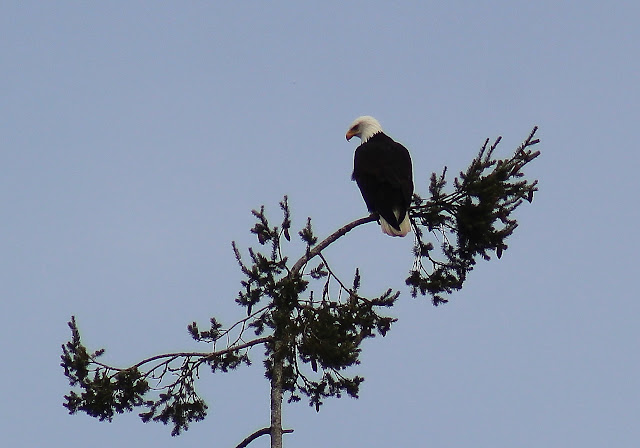This afternoon, I drove out to the Hawks Prairie Settling
Ponds.
 |
| Mount Rainier with its head in the clouds |
At this 40 acre site, operated by the
LOTT (Lacey-Olympia-Tumwater-Thurston County) Clean Water Alliance on Hogum Bay
Road in Lacey, Class A Reclaimed Water circulates through a series of five
constructed wetland ponds.
 |
| Gadwalls and a Ring-necked Duck |
Water from the ponds then flows to rectangular
groundwater recharge basins. From there, the water infiltrates through the soils
to replenish groundwater. The site is
open to the public and features walking trails, viewing benches, wildlife,
native plantings, and kiosks with information about reclaimed water.
The north side of the site used to be
an open field, with grasses and some Scotch Broom, and bordered by
second-growth Douglas fir woods. Then, a
year ago, there began construction and development of the properties to the
north of the LOTT facility.
 |
| Construction in January 2018 |
Now, the north ponds butt up against a
road and stark walls of warehouses.
 |
| January 2019 |
The many acres of industrial buildings
will likely provide an increased tax base for the City of Lacey, but is part of
the on-going loss of open space and wildlife habitat in south Puget Sound.
These forty acres at the settling ponds
are a bit louder now with the current construction, and increased semi-trailer
traffic, but still provide an oasis for wildlife and the public. Because the water comes into the facility
with quite a bit of nutrient load, there is good growth of aquatic plants. This time of year, the American Wigeon and
Gadwalls feed extensively on the duckweed growing at the ponds’ surfaces.
 |
| It's called "Duckweed" for a reason . . . . |
The LOTT folks have planted the site
with “native plants”. The original
prairie soils at the site may not be the most appropriate for Sitka Spruce,
which tend to thrive along the alluvial and wetland soils of riparian
sites.
 |
| Sitka Spruce needles and cones |
Growing on less than optimal
sites result in the trees becoming stressed during the dry season and
such. And, the stressed trees are
consequently more susceptible to being impacted by diseases and insects.
 |
| These are NOT cones . . . |
These “cones” are actually the galls of
the Cooley spruce gall adelgid, Adelges
cooleyi. These “woolly aphids” are a
small family (Adelgidae) of true bugs (Hemiptera) closely related to the aphids.
Overwintering females on spruce lay eggs near developing buds. Nymphs hatch as
bud caps split. Nymphs feed at the base of developing buds in spring producing
cone-like galls on the tips of blue spruce branches. Galls open in mid-summer.
Emerging adelgids either continue to live on spruce or fly to Douglas-fir to
lay eggs. On Douglas-fir they may continue to live or produce a generation that
flies back to spruce to produce the gall-forming stage. On Douglas-fir, feeding
on needles by nymphs produces yellow spots and curled needles but no galls.
The Douglas firs here provide perches
for many birds, including Bald Eagles,
 |
| Adult Bald Eagle |
who would enjoy lunching on waterfowl
 |
| Green-winged Teal drake |
However, many of the firs around here have either
died, or have dead tops, likely a result of the Laminated Root Rot caused by
the fungal pathogen Phellinus weirii. Laminated
root rot is one of the most damaging root diseases amongst conifers in
northwestern America.
 |
| Stress kills . . . |
The conifers are not the only trees here
impacted by bugs and disease. The
Pacific madrona is native along the coast from British Columbia to
California.
 |
| Young madrona - the Canadians call them "Arbutus" |
Many of the madronas here
have a leaf blight, consisting of brown, desiccated leaves occurring mainly in
the lower canopy.
 |
| Madrona Foliar Blight - the ugly brown spots |
This foliar blight has
been observed on Pacific Madrona throughout its range and generally occurs
during periods of wet spring weather. In
May 2009 and 2011 severe outbreaks occurred in western Washington and Oregon. A fungus was isolated from blighted foliage,
leaf spots on emerging foliage, lesions on green shoots, and from the petiole
and leaf blade of dead, attached leaves. The fungus was identical to the type isolate
of Phacidiopycnis washingtonensis, which has been reported to cause rots of
stored apple and persimmon fruit and cankers and twig dieback of apple and
crabapple trees, but had not been reported on other plant species.
 |
| Leaf miners write in their own language |
The ‘ghost scrawl’ on some of these
leaves is caused by the Serpentine madrona miner (Marmara arbutiella), which is a tiny species of moth. Larvae of this leaf- and twig-mining moth
blaze sinuous, serpentine mines across the surface of leaves. Although damage
might be unsightly on individual leaves, they do not usually affect the
long-term health of the tree. This moth affects madrona throughout its range.
But, all was not disease and
infestation, and I enjoyed seeing the usual birds, including this Song Sparrow
 |
| Song Sparrow on Common Cattail head |
and a flock of Bushtits
 |
| Female Bushtits have yellow eyes, |
 |
| and the males have dark eyes |
Hawks Prairie SP eBird Checklist is
Here
















No comments:
Post a Comment